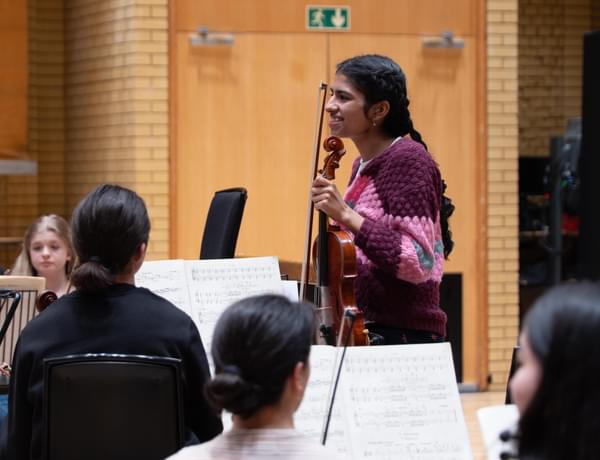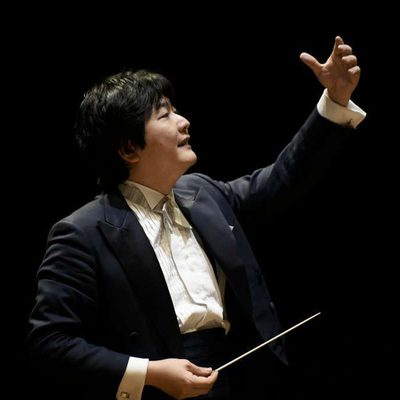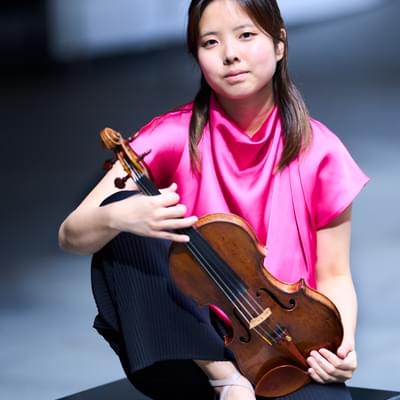CBSO Youth Orchestra: Mendelssohn 5

Full programme
- Fanny Mendelssohn, Overture in C (10mins)
- Bruch, Scottish Fantasy (30mins)
- Mendelssohn, Symphony No.5 (Reformation) (28mins)
Performers

Kazuki Yamada
Conductor
Hana Chang
Violin
This concert has been made possible with generous support from The Leverhulme Trust, Birmingham Arts Society, Gwyn Williams Bursary Fund, James Langley Memorial Foundation, Blythe Major Memorial Fund; and the Clive Richards Foundation, principal supporter of the CBSO’s work with young people.
Introduction
Welcome to this afternoon’s concert! I’m delighted to be leading the Youth Orchestra today as we celebrate our 20th anniversary.
The concert opens with Fanny Mendelssohn-Hensel’s Overture in C. The piece emerges almost from nothing, starting with the dominant played in unison by the horns. The shy character of the opening is soon interrupted by a sparkling run in the violins. I particularly enjoy the bubbling energy of the repeated notes of the next section which is later contrasted with a beautifully pastoral melody.
For the next work, we’re delighted to be performing with Hana Chang, an exceptional violinist and BBC New Generation Artist. Bruch’s Scottish Fantasy begins with a mournful theme, before a beautiful transition leads into a glorious melody in the tonic major. The harp, an important instrument in Celtic music, makes the music sound even more magical. Throughout you’ll hear a variety of Scottish folk melodies, do listen out for how they are embellished throughout in the solo part, I especially like the sparkling virtuosity of the finale.
We conclude with Felix Mendelssohn’s Fifth Symphony. The first movement begins with a contemplative, religious mood later interrupted by a dramatic minor theme, culminating with the whole orchestra playing fortissimo octaves. A highlight of this symphony for me is the beautiful aria-like melody in the third movement accompanied by the pulsing lower strings. Mendelssohn was a great admirer of Bach’s music – look out for the chorale melody used in Bach’s Cantata “Ein feste Burg ist unser Gott” in the last movement. The bright and celebratory finale concludes with a tutti statement of the chorale, where all previous tension is forgotten.
We have all enjoyed coming together to rehearse and perform this week, and are thrilled to be playing under the baton of the brilliant Kazuki Yamada. We hope that we share our joy with you this afternoon!
George Boyes
Leader
Programme notes
Members of the CBSO Youth Orchestra get the chance to experience the joy of our wonderful Music Director, Kazuki Yamada, in a glorious afternoon of music. Bruch’s Scottish Fantasy, inspired by beautiful Scottish folk melodies, is performed today by YCAT Artist and one of Classic FM’s Rising Stars of 2024, Hana Chang. The concert opens with the lush melodies of Fanny Mendelssohn's Overture in C Major, and closes with her brother's dramatic Reformation Symphony.
Overture in C major
Fanny Mendelssohn (1805-1847)
The Mendelssohn children grew up surrounded by music. Fanny was the pianist, Felix the violinist and their younger brother Paul was the cellist. Paul went on to pursue a career in finance, but Felix and Fanny both went on to be published composers, with Felix initially publishing several of Fanny’s songs under his own name - principally, it seems, as a gesture of kindness. It wasn’t considered respectable that a woman of marriageable age should publish music under her own name, although Fanny’s husband Willhem Hensel – whom she married in 1829 - was highly supportive of her composing.
The Mendelssohn family home at 3 Leipzigerstrasse, Berlin, was extensive – big enough that the newlywed Hensels could have an entire wing of their own, from which Fanny could host regular concerts for Berlin’s music-lovers Usually, they involved classics by Beethoven, Bach and Mozart. But the concert on 15 June 1834 was a bit different: musicians from the orchestra of the Königstadt Theatre assembled under their conductor Julius Lecerf to give the premiere of Fanny’s own Overture in C major. She described what happened next in a letter to Felix:
"Mother will have told you how I stood up there with a baton in my hand like Jupiter the Thunderer. My overture was played and I sat at the piano, then temptation in the form of Lecerf whispered to me to take the baton in my hand. Had I not been so shy, and embarrassed with every stroke, I would have been able to conduct reasonably well."
But she had no reason to be shy about her Overture, which she’d composed in the spring of 1832 – her first (and only) purely orchestral work. Scored for a big orchestra (by the standards of the time) complete with four horns, it’s poetic, colourful and assured, and although she never said whether it was inspired by a particular story or image, it tells its own tale in purely musical terms. Strings and woodwinds exchange quiet confidences in the serene opening section, before, with a brilliant flourish from the violins and stirring calls from the trumpets and horns, the music accelerates into a sparkling high-Romantic adventure: Allegro di molto. There’s tenderness as well as drama, before the music sweeps to a triumphant finish.
Scottish Fantasy for violin and orchestra, with harp, Op.46
Max Bruch (1838-1920)
Introduction (Grave) – Adagio cantabile
II. Allegro
III. Andante sostenuto
Finale: Allegro guerriero
Educated Europeans of the 18th century travelled to Italy to absorb the beauties of classical Rome. But in the 19th century – the era of Romanticism – tastes were stronger: it was all about storm-swept mountains, sublime vistas and ancient tales of war and passion. And where better to find those things than in Scotland, or at least the Scotland portrayed in the novels of Walter Scott (1771-1832)? Scott’s swashbuckling tales of Highland rebels and warring clans were Europe-wide bestsellers, while for those of a more poetic frame of mind there were the epic verses of Ossian, a rediscovered Gaelic bard. (It later turned out they were a hoax - but by then they’d captured the imagination of a generation).
Max Bruch was born in Cologne and he never visited Scotland (though he did spend three years on Liverpool, and at one point planned to start a music college in Edinburgh). But he felt the pull of the Highlands nonetheless, and he composed his Scottish Fantasy in 1880 for the flamboyant Spanish violinist Pablo de Sarasate. It was premiered in Liverpool in February 1881 by Brahms’s great friend Joseph Joachim – and although the critics were initially sniffy, Bruch pointed out with pride that Sarasate and Joachim were two of the greatest violinists alive, and that they loved it. So too – then and now – did the public.
It’s easy to hear why. Bruch borrowed his Scottish melodies from a textbook, but he knew a good tune when he heard one, and his love of Walter Scott did the rest. A harp (suitably Gaelic) joins the violin in the opening movement - based on the folksong Auld Rob Morris and inspired (said Bruch) by the image of “an old bard, who contemplates a ruined castle and laments the glorious days of old”. The violin imitates bagpipes in the spirited second movement (based on the dance tune The Dusty Miller) and then sings its heart out against a glowing, misty landscape in the third (which opens with the folksong I’m Down for Lack of Johnnie). The sun sinks over the glens, and then, with a warlike (guerriero) skirl, the violin launches the finale, to the spirited strains of Robert the Bruce’s battle-cry, Scots wha hae! The solo violin performs feats of agility worthy of the Highland Games on the way to the final flourish.
Symphony No.5 in D minor, Op.107 (Reformation)
Felix Mendelssohn (1809-1847)
I. Andante – Allegro con fuoco
II. Allegro vivace
III. Andante
IV. Andante con moto – Allegro vivace
Felix Mendelssohn was born into a long line of Jewish intellectuals, but he was baptised a Christian. He knew that the summer of 1830 would see celebrations across Germany to mark the tercentenary of the Augsburg Confession in 1530, and as an ambitious young composer, he felt that a symphony to mark the occasion might make quite a splash. His imagination started to bubble during a trip to Britain in the summer of 1829. Back in Berlin, he battled an attack of measles and completed the symphony on 12th May 1830. He asked Fanny to suggest titles:
‘Reformation’ symphony, ‘Confessional’ symphony, Symphony for a Church Festival, ‘Juvenile’ symphony, whatever you like. Send me at least one sensible idea – but make sure to include all the silly ones too.
Felix opted for “Church Symphony” but in the end, “Reformation” was the title that stuck. He’d left it too late for the symphony to be included in the official celebrations, and its Berlin premiere, in 1832, left the critics nonplussed and Mendelssohn disappointed. He withdrew the symphony and considered burning the score. It would lie unheard until 1868, 21 years after his death – when, since there were already four published Mendelssohn symphonies, it was described (again, the number has stuck) as his Fifth.
Yet the Reformation symphony is one of the most original works of its time. The musical drama is easy to follow, and is played out principally in the first and last movements. A slow introduction (like day emerging from night) leads to a tumultuous struggle, heralded by solemn and martial trumpets. After all, the age of Luther had not been peaceful. The finale completes and resolves the conflict.
In between come two movements that provide relief and reflection: a dancing scherzo and a melancholy, meditative Andante. And along the way, two pieces of sacred music help Mendelssohn tell his story. Martin Luther’s famous hymn Ein feste Burg enters softly in the slow introduction to the finale. Like his hero Bach, Mendelssohn uses it as a sort of foundation throughout the fourth movement, and it’s destined to crown the whole symphony.
The other sacred motif is the serene, prayer-like motif known as the Dresden Amen, originally composed by Johann Naumann (1749-1801) (though opera buffs will recognise it from Wagner’s Parsifal). Mendelssohn quotes it in the first and the third movements: a symbol of reconciliation and faith, gently lighting the way forward. The real triumph in the “Reformation” symphony is that of tolerance. As Mendelssohn wrote to his fellow-composer Julius Rietz, in 1841, the symphony embodies “the contrast between Jesuit churches with their thousand glittering ornaments, and the Calvinists with their bare white walls”. “True piety may exist in both”, he observed – “but the best path lies between the two”.
© Richard Bratby